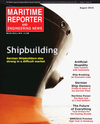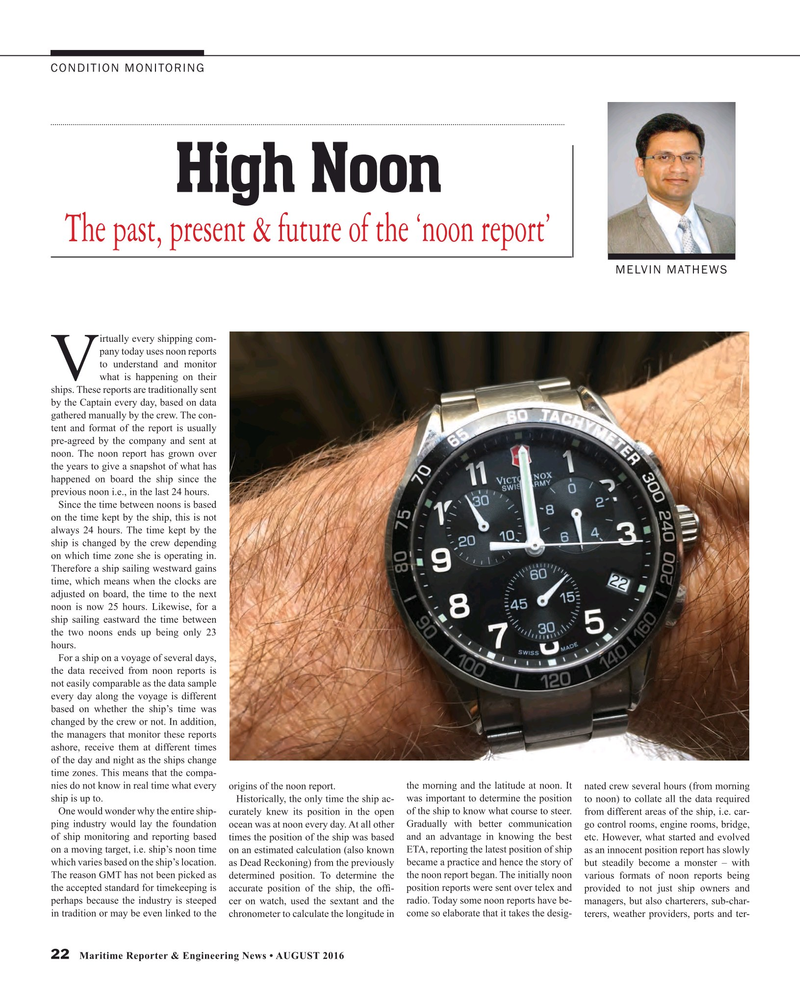
Page 22: of Maritime Reporter Magazine (August 2016)
The Shipyard Edition
Read this page in Pdf, Flash or Html5 edition of August 2016 Maritime Reporter Magazine
CONDITION MONITORING
High Noon
The past, present & future of the ‘noon report’
MELVIN MATHEWS irtually every shipping com- pany today uses noon reports to understand and monitor
Vwhat is happening on their ships. These reports are traditionally sent by the Captain every day, based on data gathered manually by the crew. The con- tent and format of the report is usually pre-agreed by the company and sent at noon. The noon report has grown over the years to give a snapshot of what has happened on board the ship since the previous noon i.e., in the last 24 hours.
Since the time between noons is based on the time kept by the ship, this is not always 24 hours. The time kept by the ship is changed by the crew depending on which time zone she is operating in.
Therefore a ship sailing westward gains time, which means when the clocks are adjusted on board, the time to the next noon is now 25 hours. Likewise, for a ship sailing eastward the time between the two noons ends up being only 23 hours.
For a ship on a voyage of several days, the data received from noon reports is not easily comparable as the data sample every day along the voyage is different based on whether the ship’s time was changed by the crew or not. In addition, the managers that monitor these reports ashore, receive them at different times of the day and night as the ships change time zones. This means that the compa- nies do not know in real time what every origins of the noon report. the morning and the latitude at noon. It nated crew several hours (from morning ship is up to. Historically, the only time the ship ac- was important to determine the position to noon) to collate all the data required
One would wonder why the entire ship- curately knew its position in the open of the ship to know what course to steer. from different areas of the ship, i.e. car- ping industry would lay the foundation ocean was at noon every day. At all other Gradually with better communication go control rooms, engine rooms, bridge, of ship monitoring and reporting based times the position of the ship was based and an advantage in knowing the best etc. However, what started and evolved on a moving target, i.e. ship’s noon time on an estimated calculation (also known ETA, reporting the latest position of ship as an innocent position report has slowly which varies based on the ship’s location. as Dead Reckoning) from the previously became a practice and hence the story of but steadily become a monster – with
The reason GMT has not been picked as determined position. To determine the the noon report began. The initially noon various formats of noon reports being the accepted standard for timekeeping is accurate position of the ship, the of? - position reports were sent over telex and provided to not just ship owners and perhaps because the industry is steeped cer on watch, used the sextant and the radio. Today some noon reports have be- managers, but also charterers, sub-char- in tradition or may be even linked to the chronometer to calculate the longitude in come so elaborate that it takes the desig- terers, weather providers, ports and ter- 22 Maritime Reporter & Engineering News • AUGUST 2016
MR #8 (18-25).indd 22 8/1/2016 2:07:26 PM

 21
21

 23
23
